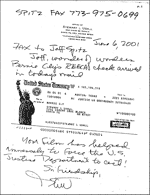
 |


|
||||
 |
 |
 |
||
EPA Destroys Radioactive Hogan by Larry Di Giovanni, Staff Writer MONUMENT VALLEY, Utah Elsie Mae Begay wasn't home when the U.S. Environmental Protection Agency came knocking at the door. She was traveling on her way home from Phoenix. So the first-known case of the U.S. government removing a Navajo abode made of highly radioactive uranium tailings bricks proceeded without her and with little fanfare. On a cloudless spring day, just a mile from Goulding's Lodge on the Begay homestead, the quick, 30-minute length of the event belied its historical significance. Several structures on the Begay property are located underneath power lines, and above them, tall, red mesas hide long-abandoned uranium mines. Begay lives within the Oljato Chapter of the Navajo reservation. Removing the small hogan was an easy feat, requiring just two contracted workers employed by CET Environmental, based in Seattle. Donning white radiation-proof suits with yellow boots, backhoe operator Mark Conway quickly demolished the home while water truck operator Ed Zitnik hosed down the structure to keep the dust level down. Supervising Wednesday's event was a CET response manager and Dan Suter, the U.S. EPA Region 9's on-scene coordinator from its Emergency Response Office in San Francisco. The demolition work began at about 11:30 a.m. An "easy" job "I've never tore a house down like this before," Suter said. "It's very straightforward. Lots of times with this type of work there are too many unknowns." What is known is that the small hogan used in recent years only as a storage shed, and determined by U.S. EPA to contain dangerously high radiation readings was built about 40 to 45 years ago. The last items taken out Wednesday before demolition were an old couch, two tires and an engine block. Begay lived in the house with her children from the late 1970s to the early 1980s. Prior to that, other relatives lived in the small hogan made of uranium tailing bricks taken from nearby uranium mines, which are long since abandoned. One of the relatives who lived in the home was her aunt, Mary Holiday, who is still alive. Other relatives weren't so fortunate. Begay's son, Louis, died when he was just 24 years old. Several male family members who worked in the uranium mines died of cancers and respiratory illnesses they believe to be linked from exposure to harmful radon gas. Its small alpha particles, invisible to the human eye, lodge in the lungs and cause lung cancer. Suter said the Begay hogan and another U.S. EPA project removed this week in Teec Nos Pos, Ariz., near Shiprock, N.M. had what are considered "dramatic" radiation readings. A micrometer read off between 800 and 1,000 microroentgens per hour in these homes. A micrometer measures exposure to gamma radiation, which unlike radon gas, "shoots right through you" but can also cause severe health problems given long-term exposure. Prolonged exposure to 150 microroentgens per hour is the borderline figure for serious health risk hazards. A reading of 1,000 microroentgens is more than 80 times the level of normal "background" radiation. Suter called exposure to radon gas and gamma radiation inside a "uranium" home a "double-whammy." Gamma radiation gives a person a "full-on body exposure" to radioactivity. "It's not a huge health hazard unless you were living inside," he said. "Then, it's significant ... you can never be for sure, but I would say there are long-term health problems with that kind of exposure." The "uranium" home in Teec Nos Pos belonged to the family of Betty Clark. Her husband, who worked in area uranium mines, died when he was 30. "Working the mines during the day and sleeping inside that home at night, I'm sure he took a pretty good dose (of radiation)," Suter said. Possible survey The "logical thing" to occur in the near future would be for Navajo EPA, the Navajo Office of Abandoned Mine Lands and the tribe's Superfund Program to coordinate a survey of all remaining "uranium" homes on the reservation, Suter said. According to the Begay family, there may be as many as five to six such homes just in the Monument Valley area alone. "Personally, I think they should (complete a survey) as soon as possible," Suter said. "But I just run the field jobs." U.S. EPA's Region 9 was given a budget of almost $150,000 to remove the Begay and Clark homes, Suter said. But the actual cost should be closer to $50,000. The remains of Begay's hogan were taken to nearby Moonlight Mine, which is becoming a repository for uranium waste ore. The U.S. EPA will hand over a $3,000 check to Elsie Mae Begay to cover the cost of a new storage shed. She lives now in a much larger hogan built by her family and only about 100 yards from the demolished "uranium" home. The lower half of the Begay hogan's outside walls about the first three feet up were made of the uranium tailings bricks. The concrete-like portion above the bricks consists of sand granules also taken from the mines. Such a concrete mixture is deceptively deadly and more a threat than uranium tailings bricks because unsuspecting tenants may not have any idea what the material consists of. "That adds another caveat to this story," said Andrew Sowder, a Washington-based EPA fellow and researcher with the American Association for the Advancement of Science. "Just because a building isn't made of stone doesn't mean it doesn't have harmful radioactivity." In January, U.S. Rep. Patrick Kennedy, D-R.I., the youngest child of Massachusetts Sen. Ted Kennedy, visited Begay's home. The founder of the Native American Caucus in Congress, he pledged his support to help the Navajo Nation resolve uranium hazard issues, including uranium mine remediation. Kennedy said he was particulary concerned that the Navajo children of today may be exposed to harmful radiation, some of which comes from water sources close to abandoned mines. Begay on way home As it happened Wednesday, Elsie Mae Begay was likely driving back to her home at the same time her "uranium" home was being demolished. Jeff Spitz, an independent film maker from Chicago, had provided her way there over the previous weekend, where she and her brother, John Wayne Cly, were recognized as living legacy survivors of Cold War contamination issues. Begay and Cly were honored by Prairie Earth, a nonprofit organization that is part of the Unitarian Universalists, Spitz said. Spitz made the film "The Return of Navajo Boy," released last year, a Sundance Film Festival winner and well-received documentary about family separation and a reuniting more than 40 years later. After their mother died, Cly, just an infant at the time, was taken away from his family. He now lives in New Mexico's Zuni reservation. Spitz said it's a travesty that Begay repeatedly attempted to receive health screenings for radiation exposure, and was turned away from the Indian Health Service hospital twice in Shiprock. She was accepted for a screening on her third attempt. Though the Radiation Exposure and Compensation Act of 1990, amended last year, provides screenings for former uranium miners and now millers, their dependents have had a much more difficult time gaining medical attention related to their exposure. "It's another coordinated human rights abuse that is going on," Spitz said. "There are more and more people that are seeing the injustice now." For more information go to: www.navajoboy.com |
||||
| THE U.S. DEPARTMENT OF JUSTICE HAS APPROVED BERNIE CLY'S CLAIM FOR COMPENSATION. BUT THERE IS A CATCH... | |
 |
Instead Of $100,000, Radiation Victims Get IOUs Former uranium miners who qualify for federal payments to compensate for radiation-related illnesses instead are getting IOUs (= I owe you) from the government. Several former miners recently received letters saying they qualified for $100,000 payments each, but the money is not available now. (Albuquerque Journal, Aug. 15, 2000) The Justice Department has 242 approved but unfunded claims from former miners or their families. They have waited for months, some since May, for the government to fulfill promised, compassionate $100,000 payments - payments that Congress has since boosted to $150,000. (The Daily Sentinel, December 10, 2000) click links to see Petition Letter for IOU holders IOU from Government |